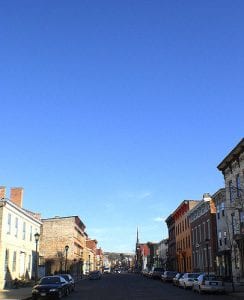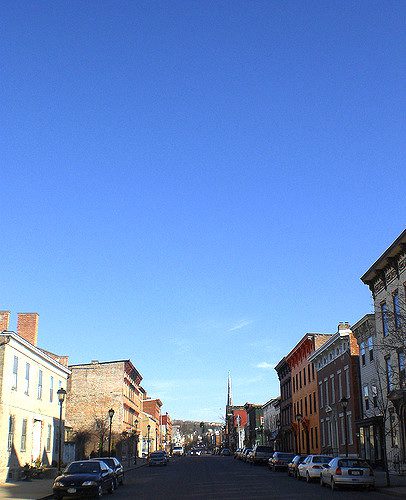
‘Hudson, NY’ by Melissa Stafford via flickr, CC BY 2.0
On a vacation drive through New York’s Hudson Valley recently, I was reminded how towns and cities in the U.S. are as segregated today as they ever were. Big cities, small towns, shrinking cities, growing cities, liberal and conservative ones. Mine is not an original discovery, but it turned out to be timely.
This year marks the 50th anniversary of the bold report by the National Advisory Commission on Civil Disorders (also known as the Kerner Commission), which warned that the nation was “moving toward two societies, one Black, one white—separate and unequal.” The commission was set up after widespread civil disorder following the assassination of Martin Luther King Jr. in 1968. At that time the racial divide was also a clear territorial divide, between Black central cities and white suburbs.
The Fair Housing Act of 1968 was signed to induce state and local governments to end residential segregation. There have been modest successes since then, but by and large, segregation and housing discrimination remain. The shape of the territorial divide has morphed and is more complex, with many divides within cities and within suburbs. However, the social and economic disparities behind the spatial divides remain in place.
These continuing problems were the subject of thoughtful analyses in the January-March, 2018 issue of Poverty & Race dedicated to “Reflections on Kerner at 50.” Aside from the consensus among authors that much remains to be done, several contributors remind us, as the Kerner Commission asserted, that the problem is not just the spatial separation of communities, but this separation is an expression of structural racism. Sherrilyn Ifill, for example, notes: “The railroad tracks are not just a geographic marker. They are also a physical manifestation of racism itself.” And in a recent article published by Shelterforce, housing historian Fred McGhee comes to a similar conclusion.
Missed Opportunities: New Growth Areas
Even while historic patterns of segregation in older cities persist, segregation is sprouting anew in rapidly developing towns and cities across the country. We can understand how difficult it is to break segregation patterns in older cities, but it is no less obvious in newly developing places.
The town of Hudson, New York, population 6,713, is a growing ”exurb” beyond the fringes of the New York metropolitan region. In the 19th century it was an active industrial center but with the massive flight of industry and the rise of container shipping starting in the 1970s, the mostly white industrial towns in the Hudson Valley lost significant population.
After the second World War, when industry restructured and fled, Hudson and other river towns lost jobs and population. It was far enough from New York City that it languished for decades. However, as the New York metropolitan region grew, skyrocketing urban and suburban real estate prices began to push more white urbanites and suburbanites out of their homes. As technology reduced barriers of time and space, more and more people moved to places like Hudson.
First came artists—ever seeking low-rent spaces to create and sell their art. Then the Silicon Alley subcontractors, the telecommuters, the urban farmers, the retirees, and second-homers. And now, Hudson is hopping! It has music, theater, art—everything an urbanite would want. It is a progressive bastion under Democratic Party rule in a region long dominated by Republicans.
This new hip destination is clearly segregated by race and class. The main street running through the center of town, Warren Street, is a bit like Manhattan’s Fifth Avenue, though obviously much more humble and low-rise. It has restaurants, art galleries, and boutiques, and rents outpacing anything around them. On one side of Warren Street is a mostly white neighborhood and on the other is a mostly Black and Latinx neighborhood. Warren Street serves very much the same function as the proverbial railroad tracks.
I was surprised to discover a bodega on Warren Street that seemed to mainly serve a Black and Latinx population, but because of its location, also got some gallery goers. Surely there is a lot of crossover, just as there has been historically in East Harlem and Bedford Stuyvesant in New York City, but the structure of racial separation is clearly visible. It works not through Jim Crow laws but through the real estate market, which is chronically immune to fair housing laws. Local, state, and federal government has been unable, or unwilling, to end racial steering, but until the market institutions that sustain segregation are placed under strict public control by political leadership that goes beyond platitudes to Martin Luther King Jr., this will remain the reality. I think this is a cautionary tale of special importance for those of us pressing for a “political revolution.”
It’s Race Not Place
We should have known better. The Kerner Commission taught us that race matters most, not place. But it also embedded in our psyches the equation of Black = central city and the similarly absolute equation of white = suburbs. In 1968 this sweeping bifurcation was mostly accurate. Black Detroit suffered while the white suburbs around it flourished. But this simplistic dualism ignored the obvious fact that while Harlem was ravaged by abandonment, its next-door neighbor to the south—the Upper East Side, arguably the wealthiest neighborhood in the world—flourished.
It was not really central city vs. suburb; it was basically Black vs. white, which also had a spatial dimension that varied from one place to the next. By focusing on predominantly Black neighborhoods like Harlem, the body politic conveniently removed from the discussion the privilege and wealth of the Upper East Side.
I entered a post-graduate program in urban planning in 1968, lured by the power of the Kerner report and the notion that cities were the arena in which people dedicated to civil rights could bring about change. Fifty years later, however, planners remain servants to private property and the status quo, and those planners who work with progressive civic groups, lawyers, and elected officials to confront racial inequalities remain in the minority. More importantly, the professions have pulled us away from addressing structural racism and have failed to go beyond empty declarations in favor of racial equity.
It was only in the Obama administration that HUD finally got around to issuing guidelines that would “affirmatively further” fair housing, but these are now being thwarted by the Trump administration. And even if they were strongly in place, they would be weak tools that only nudge local governments and the housing and land markets toward racial equality.
Priority must be shifted from promoting integration to strategies that will end structural racism in all arenas. These include campaigns such as the “War on Drugs,” which have resulted in the mass incarceration of Black people—the ultimate expression of segregation. And an assault on racism must be coupled with honest discussions of white privilege.
In discussions about our nation’s racial divide, it is easy to forget about the ambitious efforts to redistribute wealth through the federal War on Poverty in the 1960s, which might have begun to unravel structural racism. However, those efforts quickly succumbed to the usual instruments of national and local government policy that sustain economic and social differences between races.
The Kerner Commission certainly stretched the limits of discourse on race at that time, but history tells us that segregation is only a symptom. Its roots lie in the violent theft of land by settlers, the basis for our institution of private property, and the violent theft of African people, the basis for slavery, racism, and segregation. It’s time to dig out the roots.





When did the U.S. have a priority on promoting integration? Has it ever really been tried in any concerted way or with the meaningful levels of resources that the Kerner Commission said would be needed? The manifestations of structural racism that the author cites, such as the War on Drugs and mass incarceration, are not justifications for ‘shifting the priority away from integration.’ To the contrary. As the Kerner Commission predicted, if the U.S. failed to integrate then this kind of ‘control and contain’ policing that is required just to maintain a segregated society. Perhaps this is just a chicken and egg issue, but it seems apparent that dismantling segregation is the key to dismantling structural racism in its many forms.